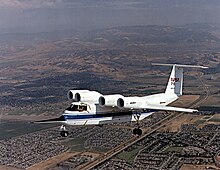de Havilland Canada DHC-5 Buffalo
The de Havilland Canada DHC-5 Buffalo is a short takeoff and landing (STOL) utility transport turboprop aircraft developed from the earlier piston-powered DHC-4 Caribou.The Buffalo arose from a 1962 United States Army requirement for a STOL transport capable of carrying the same payload as the CH-47A Chinook helicopter.No further US orders followed, however, as at the start of 1967 (See the Johnson-McConnell agreement of 1966), inter-service politics led to large fixed-wing transports being transferred to the United States Air Force,[2] who considered themselves adequately equipped with the Fairchild C-123 Provider.In December 2008, Viking Air indicated their intention to put the Buffalo series back into production at their home factory in Victoria, British Columbia or in Calgary, Alberta.[9] In late 1965, one of the prototype DHC-5s operated by the U.S. Army was deployed to Bien Hoa Air Base in South Vietnam for a three-month evaluation period, assigned to the 2nd Flight Platoon of the 92nd Aviation Company.On 9 August 1974, Canadian Forces CC-115 Buffalo 115461 was shot down by a Syrian surface-to-air missile, killing all nine CF personnel on board.[11] In 1975, the Buffalo dropped its tactical transport role and was converted to domestic search and rescue, except for a few that kept serving on UN missions.The number of aircraft have been reduced to eight, with six on active service, one in storage (recently dismantled) and one used for battle damage training.[13] However, after changes in Canada's defence budget as well as accusations of bias from the aerospace industry,[citation needed] the Buffalo replacement program was relaunched as an open competition.A cooperative NASA/Canadian Government research program on augmentor wing concepts started in 1965 and culminated in the need for a proof-of-concept aircraft.[17][18][23]: 153 [24][25][26] Boeing designed and installed an experimental swept, supercritical wing incorporating a boundary layer control system.[25]: 9–10 In 1980, this aircraft participated in carrier trials aboard USS Kitty Hawk, demonstrating STOL performance without the use of catapults or arrestor gear.










442 Transport & Rescue SquadronRockcliffe AirportOttawaUtility aircraftManufacturerde Havilland CanadaRoyal Canadian Air ForceDe Havilland Canada DHC-4 CaribouturbopropDHC-4 Cariboulight aircraftUnited States ArmyCH-47A ChinookGeneral Electric T64turbopropsPratt & Whitney R-2000piston enginesEgyptian Air ForceParis Air ShowJohnson-McConnell agreement of 1966United States Air ForceFairchild C-123 ProviderFarnborough AirshowViking AirVictoria, British ColumbiaCalgary, AlbertaPratt & Whitney Canada PW150glass cockpitnight vision goggleEADS CASA C-295letters of intentBien Hoa Air BaseVietnamU.S. ArmySouth Vietnam92nd Aviation CompanyNo. 429 SquadronNo. 442 SquadronNo. 413 SquadronNo. 424 SquadronNo. 426 SquadronMiddle EastCanadian Forces CC-115 Buffalo 115461Syriansurface-to-air missileBrazilSearch and RescueCFB ComoxCC-130 HerculesCFB GreenwoodCFB TrentonAleniaC-27J SpartanAirbus Defence and SpaceEmbraerKC-390Canada Aviation and Space MuseumBoeingRolls-Royce SpeyNASA Ames Research CenterDepartment of Industry, Trade and Commercesupercriticalboundary layer control systemAvco Lycoming YF102Northrop YA-9Coandă effectUSS Kitty HawkAmes Research CenterMountain View, CaliforniaUS ArmyBrazilian Air ForcePeruvian Air ForceCanadaSummit AirOman PoliceArctic Sunwest ChartersEthiopiaEthiopian AirlinesMalawiGaleao AirportForce Aérienne ZairoiseAbu DhabiUnited Arab EmiratesUnited Arab Emirates Air ForceCameroonCameroon Air ForceChilean Air ForceDemocratic Republic of the CongoAir Force of the Democratic Republic of the CongoEcuadorEcuadorian Air ForceEcuadorian ArmyIndonesian NavyIndonesiaIndonesian ArmyKenya Air ForceMauritaniaMauritanian Air ForceMexicoMexican NavyRoyal Oman PoliceSudanese Air ForceTanzaniaTanzania Air Force CommandMilitary of TogoUnited StatesZambiaZambian Air ForceUnited Nationsshot down over SyriaMauritania Islamic Air ForceAhmed Ould BouceifLusaka AirportLusakaMoi Air Basecarrying most of the Zambian national footballLibrevilleAspect ratioAirfoilGeneral Electric CT64-820-4Hamilton StandardAeritalia G.222Antonov An-32Transall C-160List of active Canadian military aircraftList of carrier-based aircraft